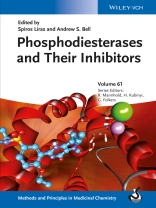Written by the pioneers of Viagra, the first blockbuster PDE inhibitor drug.
Beginning with a review of the first wave of phosphodiesterase (PDE) inhibitors, this book focuses on new and emerging PDE targets and their inhibitors. Drug development options for all major human PDE families are discussed and cover diverse therapeutic fields, such as neurological/psychiatric, cardiovascular/metabolic, pain, and allergy/respiratory diseases. Finally, emerging chemotherapeutic applications of PDE inhibitors against malaria and other tropical diseases are discussed.
Inhaltsverzeichnis
INTRODUCTION
TOWARD A NEW GENERATION OF PDE5 INHIBITORS THROUGH ADVANCES IN MEDICINAL CHEMISTRY
Introduction
The First-Generation Agents
PDE5 as a Mechanism and Alternative Indications Beyond MED
A Summary of PDE5 Chemotypes Reported Post-2010
Second-Generation PDE5 Inhibitors from Pfizer: Pyrazolopyrimidines
Second-Generation PDE5 Inhibitors from Pfizer: Pyridopyrazinones
Conclusions
PDE4: NEW STRUCTURAL INSIGHTS INTO A REGULATORY MECHANISM AND IMPLICATIONS FOR THE DESIGN OF SELECTIVE INHIBITORS
Introduction
Isoforms, Domain Organizations, and Splice Variants
Structural Features of the Catalytic Site
Regulation of PDE4 Activity
Crystal Structure of Regulatory Domains of PDE4
URC2 Interaction and Selectivity
Conclusions
PDE4: RECENT MEDICINAL CHEMISTRY STRATEGIES TO MITIGATE ADVERSE EFFECTS
Introduction
Brief Summary of pan-PDE4 Inhibitors
PDE4 Strategies to Avoid Gastrointestinal Events
Conclusions
THE FUNCTION, ENZYME KINETICS, STRUCTURAL BIOLOGY, AND MEDICINAL CHEMISTRY OF PDE10A
Enzymology and Protein Structure
Papaverine-Related PDE10A Inhibitors
MP-10/PF-2545920 Class of Inhibitors
PF-2545920/MP-Inspired Inhibitors
PF-2545920/Papaverine/Quinazoline Hybrid Series of Inhibitors
PET Ligand Development
Summary and Future
THE STATE OF THE ART IN SELECTIVE PDE2A INHIBITOR DESIGN
Introduction
Selective PDE2A Inhibitors
Methods
Conclusions
CRYSTAL STRUCTURES OF PHOSPHODIESTERASE 9A AND INSIGHT INTO INHIBITOR DISCOVERY
Introduction
Subtle Asymmetry of the PDE9 Dimer in the Crystals
The Structure of the PDE9 Catalytic Domain
Interaction of Inhibitors with PDE9
Implication on Inhibitor Selectivity
PDEs AS CNS TARGETS: PDE9 INHIBITORS FOR COGNITIVE DEFICIT DISEASES
PDE9A Enzymology and Pharmacology
Crystal Structures of PDE9A Inhibitors
Medicinal Chemistry Efforts toward Identifying PDE9A Inhibitors for Treating Cognitive Disorders
Analysis of CNS Desireability of PDE9A Inhibitors
Conclusions
PHOSPHODIESTERASE 8B
Introduction
Identification
Properties
Expression and Tissue Distribution
Functions of PDE8B
Inhibitors and Potential Therapeutic Uses
SELECTIVE NEW SMALL-MOLECULE INHIBITORS OF PHOSPHODIESTERASE 1
Introduction
PDE1 Enzymology
PDe1 Inhibitors
Conclusion
RECENT ADVANCES IN THE DEVELOPMENT OF PDE7 INHIBITORS
Introduction
Historical Development of PDE7 Inhibitors
Recent Advances in the Discovery of PDE7 Inhibitors for Peripheral Therapeutic Benefit
Recent Advances in the Discovery of PDE7 Inhibitors for CNS-Related Disorders
Recent Advances in the Discovery of Dual PDE7 Inhibitors
Identifying Next-Generation PDE7 Inhibitors
Summary
INHIBITORS OF PROTOZOAN PHOSPHODIESTERASES AS POTENTIAL THERAPEUTIC APPROACHES FOR TROPICAL DISEASES
Introduction
Malaria
Chagas Disease
Leishmaniasis
Human African Trypanosomiasis
Conclusion
Index
Über den Autor
Spiros Liras is the head of the cardiovascular metabolic and endocrine diseases (CVMED) medicinal chemistry department at Pfizer R&D in Cambridge, MA (USA). Previously, he was Senior Director of medicinal chemistry in Neuroscience at Pfizer, working on treatments for addiction, depression, schizophrenia, cognition and Alzheimer’s disease. In Neuroscience he worked on multiple PDE targets for the treatment of neuropsychiatric diseases including PDE10, PDE9, PDE2 and PDE1. Dr. Liras obtained his Ph D in organic chemistry in 1989 from Iowa State University. He joined Pfizer in 1994 after postdoctoral studies at the University of Texas at Austin. He is a coauthor in more than 70 publications and patents.
Andrew Bell was with Pfizer for over 30 years, following studies at York University (UK). He spent his early career working on PDE inhibitors leading to the inotrope/ vasodilator (PDE3) candidate, nanterinone, and the PDE5 inhibitor, sildenafil (Viagra, Revatio). Soon after the launch of sildenafil in 1998, he was given responsibility for File Enrichment, as part of Pfizer’s collaborations with Ar Qule and Tripos. He has subsequently applied the results of the File Enrichment investment to generate new lead series for multiple projects, including novel series of selective PDE- 4, 5, 8 and 9 inhibitors. He is currently involved in research into parasitic diseases at Imperial College, London.












